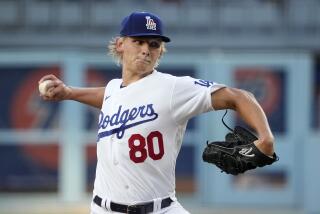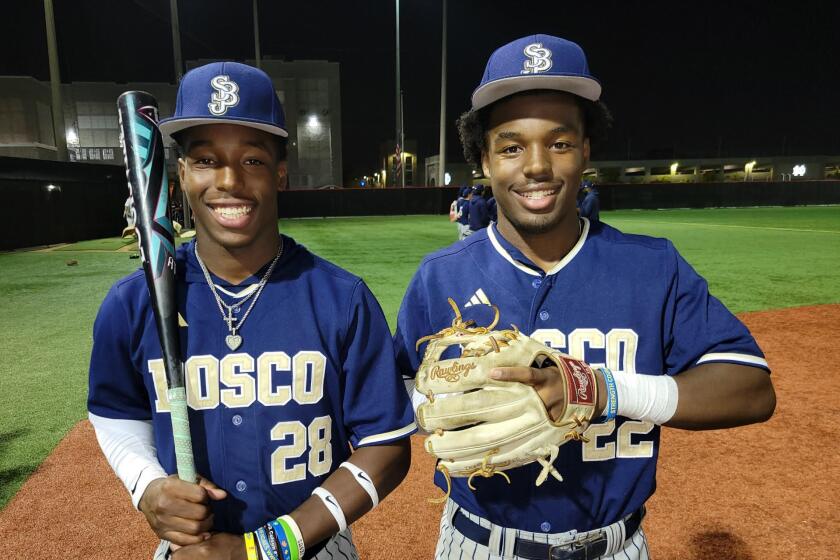A New Pitch Gives Heaton a New Lease on Baseball Life : Baseball: Pirate left-hander augments his fastball with a ‘screw-knuckle change’ to confound hitters.
- Share via
Injuries can do strange things to a baseball player. Neal Heaton’s gave him a new attitude and another pitch.
After battling tendinitis in his throwing arm the last two seasons, the Pirates’ top left-hander has emerged as one of the National League’s best pitchers.
Earlier this week, Heaton was named to his first All-Star team with a 10-4 record that has helped his East Division-leading Pittsburgh Pirates stay in a tight race with the New York Mets.
Heaton, 30 and a New York native, said his shoulder problems scared him into re-evaluating his game and his life.
“You tend to take things for granted, especially your body,” he said. “But when I hurt my shoulder, it scared me and I started thinking: Maybe I better start taking better care of myself and start working harder.
“I never had health problems in my whole life, and when I finally did, it was a major shock.”
Maybe shock therapy was exactly what Heaton needed--that and a new pitch. He credits hard work and dedication for his longevity in the major leagues. But he had a 61-83 record entering this season. He had been in the majors eight seasons and was surviving game-to-game with one good pitch--a 90-m.p.h. fastball.
According to scouts’ estimates, every batter facing Heaton would get at least two good pitches.
“I only had one pitch--basically my fastball--and they’d just sit and wait on my fastball or my breaking ball,” Heaton said. “I just didn’t have that third pitch.
“But in spring training, I was playing around, and I tried kind of a split-fingered fastball and it worked. Ever since then, I’ve used it and it’s been a great pitch for me,” he said.
It’s been called a “screw-knuckle change,” a hybrid that may be the longest-named pitch in baseball. And, for him, the most effective.
Heaton promised Pirate pitching coach Ray Miller last season that he would come to camp prepared to work on developing a new pitch. The lockout-shortened spring cut into their plans, but Miller was determined to see Heaton expand his pitching repertoire.
“I told him, ‘You’ve been up here eight years doing things your way and you haven’t been a winner. If you’re willing to learn a new pitch, I’d be willing to help you out and be willing to stay with you,’ ” Miller said.
“Neal has always been a guy nicknamed ‘Heater’ for his fastball. But that was it; he only had one pitch.
“In the first half of the season, he’d be fairly effective, and in the second half, people would get to him,” Miller said.
Heaton is at the top of his game, with a 3.47 earned-run average, 43 strikeouts and a growing respect among National League batters. But in a quieter moment in the corner of the Pirates’ locker room, Heaton credits much of his drastic turnaround to his childhood.
“When things were getting tough there for a while, I reflected back on a lot of the ideals my father instilled in me as a kid,” Heaton said. “We lived in a tough neighborhood in Queens, and living in a tough neighborhood made me a tough person.
“It teaches you that you can’t ever give up, you can’t ever quit. And that’s the attitude that you need to get over the hurdles. “
Heaton couldn’t have asked for a better training ground to learn persistence and survival. “When times are tough, you find out an awful lot about a player,” Pirate Manager Jim Leyland said. “The good ones respond; they turn the page and they respond. The ones who aren’t going to survive cave in a little bit. Neal has never caved in in his life.”
The Pirates showed their confidence in Heaton during the off-season by signing him to a three-year contract estimated at $3.6 million.
To some, spending that much on a 30-year-old free agent with one pitch and a history of shoulder problems might have seemed overly generous. Maybe even ludicrous.
But once Heaton’s shoulder problems were cared for, Leyland was confident his arm would return as strong as ever.
“He was a free agent last year and we worked hard to sign him. We were grateful he wanted to come back,” Leyland said. “We knew he had a good arm, and he’s always been a competitor. He’s never given in, even (when) it may have been easier to.
“When we first got him, he had health problems, but we knew he always had a great arm. Once he got his health back, we thought he’d make a great pitcher.”
But there were other considerations. “There were several factors that went into us signing him to that kind of a contract,” Pirate General Manager Larry Doughty said. “First, was the way he pitched last year from Aug. 1 to the end. It seems to me he was 5-0 (actually 5-1) from the All-Star break on.
“Second, throughout the ’89 campaign, we liked the intensity and competitive level he showed.
“And third, he was a pitcher who had arm trouble, but who had never been operated on. In my judgment, by the end of (last) year, he’d bounced back.
“Neal has pitched just like I thought he would. We figured he’d be a quality pitcher, especially in our division, where left-handers are a very valuable commodity.”
For those who knew Heaton as a high school senior, his success has come as no surprise. Heaton was selected by the Mets as the No. 1 draft choice in 1979, but he opted to enroll at the University of Miami. Between 1979 and ‘81, Heaton went 41-6 and was a unanimous All-American as a sophomore in 1980.
As a junior, he was 15-1, his only loss coming in the College World Series, and he struck out 23 Indiana State batters in a game.
“I learned a lot there that I wouldn’t have had time to learn had I went straight into the pros,” Heaton said. “College was a great decision at the time.”
He was drafted by Cleveland in the second round in June 1981 and, after 1 1/2 years in the minor leagues, Heaton was called up in September 1982. He was 0-2 in four starts.
The next year he was 11-7. Only Baltimore’s Mike Boddicker and Oakland’s Chris Codiroli had more victories among American League rookies that year.
He went 12-15 in ’84 and 9-17 in ’85 before being traded to Minnesota in ’86 and the Expos in ’87.
In Montreal, Heaton was 9-2 before twisting his knee in June, an injury that hindered him the rest of the season. Still, he finished 13-10.
Tendinitis cropped up in 1988, and the next two years brought records of 3-10 and 6-7 and a trade to the Pirates.
“That’s something I went through, and it was tough, but now I feel well and I keep myself in great shape,” Heaton said. “I just want to play as well in the second half (of 1990) as I did in the first half. If a hitter challenges me, I want to go right at him.”
With a fastball that’s still reaching the low 90s, a good breaking ball and his screw-knuckle change, Heaton may have been one of the Pirates’ wisest investments.
“This is no fluke. I think he’s going to be up here for a while,” Miller, the pitching coach, said. “Neal loves baseball more than 90% of the people who play baseball. And with that wide-open approach, I don’t see why he shouldn’t be able to continue winning for us.”
More to Read
Go beyond the scoreboard
Get the latest on L.A.'s teams in the daily Sports Report newsletter.
You may occasionally receive promotional content from the Los Angeles Times.










